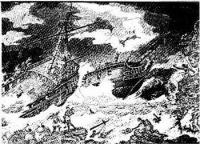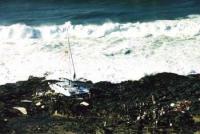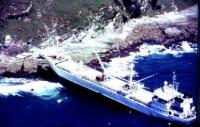 The Wild Coast partly derived its name from its wilderness character, but mostly from the pounding breakers and cauldron of its boiling seas when stormy conditions reign. This particular part of the Eastern Cape coast has been the graveyard of many a ship through the ages, and ship’s skeleton, artefacts and structures bear mute testimony to the loss of lives and vessels.
The Wild Coast partly derived its name from its wilderness character, but mostly from the pounding breakers and cauldron of its boiling seas when stormy conditions reign. This particular part of the Eastern Cape coast has been the graveyard of many a ship through the ages, and ship’s skeleton, artefacts and structures bear mute testimony to the loss of lives and vessels.
Most of these wrecks vanished beneath the waves and have been forgotten, yielding up nothing but an occasional small treasure for the beachcomber. Some are still visible as rotting hulks lying in shallow water, like the Jacaranda at Qolora Mouth or the Idomene at Qora Mouth. Some have left a legacy – the name of Coffee Bay supposedly comes from a ship that was wrecked in the bay with a cargo of coffee beans. It is said that the beans grew into short-lived coffee bushes that gave the bay its name.
 Some have left their names – it is believed that the name Port St Johns comes from the wreck of the sixteenth- century Portuguese ship Sao Joao. Mazeppa Bay’s name comes from one of the apparently few ships that made it – the British ship Mazeppa often used the bay for anchorage and survived to tell the tale. But the most famous wreck of all is that of the English ship, Grosvenor.
Some have left their names – it is believed that the name Port St Johns comes from the wreck of the sixteenth- century Portuguese ship Sao Joao. Mazeppa Bay’s name comes from one of the apparently few ships that made it – the British ship Mazeppa often used the bay for anchorage and survived to tell the tale. But the most famous wreck of all is that of the English ship, Grosvenor.
Her tragic end came on August 4th 1782, while on a return voyage from India. She ran aground then sank in a very deep gully off a rocky little bay called Lwambazi. Although only 14 of the 150 people on board drowned, just six sailors reached safety at a frontier farm near Port Elizabeth. News of the disaster prompted the colonial government to send an expedition to rescue the survivors. They only found 12. For many years, however, rumours persisted of the 'un-found' survivors living with local tribesmen, and an expedition in 1790 discovered a colony of about 400 people of non-African descent living on a tributary of the Mngazi River. These were the sad remnants of the various shipwrecks along the coast.
 The expedition found no trace of the Grosvenor. In the meantime, however, another legend had arisen: that the ship had been carrying a fortune in bullion and silver. One of the rumours insisted that the fabulous Peacock Throne of Persia (a royal chair made of solid gold with peacocks outlined in precious stones, and which had been looted round about this time) had been smuggled on board.
The expedition found no trace of the Grosvenor. In the meantime, however, another legend had arisen: that the ship had been carrying a fortune in bullion and silver. One of the rumours insisted that the fabulous Peacock Throne of Persia (a royal chair made of solid gold with peacocks outlined in precious stones, and which had been looted round about this time) had been smuggled on board.
What followed was an absurd and costly series of recovery schemes, many of which cost more than any reputed treasure on board the ship. Steam-drive cranes, suction dredgers, undersea tunnels, boulder breakwaters, high-pressure water- jets, explosives, mining efforts – even a group of spiritualists led by a ghost – made no impression whatsoever. Only two cannons and several gold and silver coins have ever recovered from the wreck of the Grosvenor. It lies there still, in its dangerous little gully, its secrets hidden by treacherous currents and drifting sand. What treasure is on board, and how to get to it, no man knows.
---------- Of historical importance at Mkambati (and tourist interest) are two famous shipwrecks, namely the Sao Bento(1554)- near the mouth of the Msikaba River - and the Grosvenor (1782) lying in Lambasi Bay.

Comments
Alwyn Carter (not verified)
Wed, 07/09/2022 - 08:16
Permalink
Hi there.... My name is Alwyn
Anthony Carr (not verified)
Wed, 23/11/2022 - 10:38
Permalink
Hello
Kimaal Manning (not verified)
Sun, 07/07/2024 - 12:04
Permalink
Hello,
Brian Matross (not verified)
Wed, 09/10/2024 - 09:29
Permalink
Hi, I know it’s hard finding
Add new comment